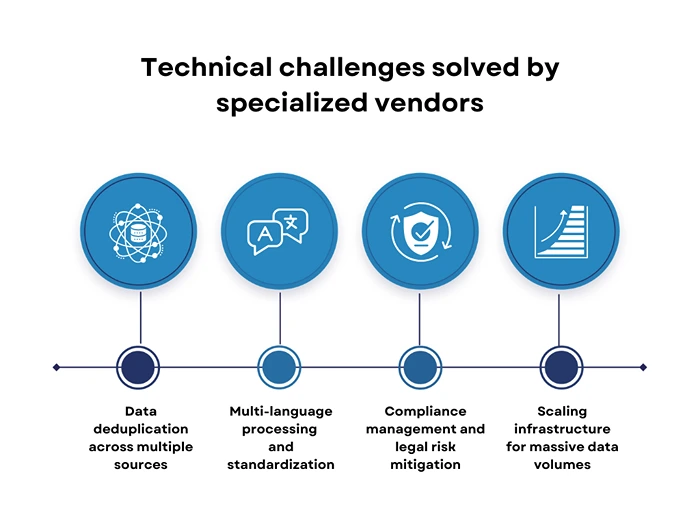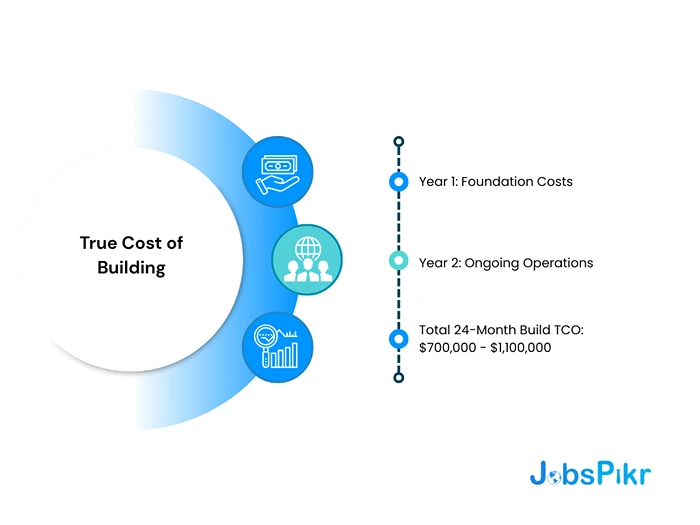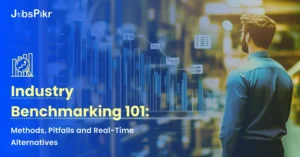- **TL;DR**
- The Strategic Landscape of Job Data Aggregation
- Decision Framework: When Build Makes Strategic Sense
- Ready to see how JobsPikr can slash your time-to-market and data engineering costs?
- The True Cost of Building: A 24-Month TCO Analysis
- The Vendor Alternative: Buy Option Economics
- Integration Patterns: Connecting to Your Stack
- Compliance and Legal Risk Assessment
- Vendor Landscape: Navigating Your Options
- Decision Matrix: Quantifying Your Choice
- Implementation Roadmap: Build vs Buy Timelines
- ROI Analysis: The Financial Reality Check
- Real-World Case Studies: Learning from Success and Failure
- Technical Deep Dive: Architecture Considerations
- Advanced Integration Scenarios
- Regulatory Landscape: Navigating Global Compliance
- Future-Proofing Your Decision
- Making the Final Decision: A Practical Checklist
- Strategic Recommendations: Making the Right Choice
- The Strategic Path Forward
- Ready to see how JobsPikr can slash your time-to-market and data engineering costs?
- FAQs
**TL;DR**
The job-market data landscape is more complex than ever, with 325,000+ new postings daily. Data and analytics teams must choose: build a custom job aggregation platform, or buy an established API like JobsPikr. This decision can impact costs by hundreds of thousands of dollars, delay projects, and affect compliance and analytics capabilities. For most organizations, buying delivers faster time-to-market, lower risk, and reduced total cost of ownership—while custom builds make sense only for those with unique strategic needs and deep technical resources.
The global workforce intelligence market has reached an inflection point. Every day, over 325,000 new job postings flood the digital landscape, creating both unprecedented opportunities and complex challenges for organizations seeking to harness this data.
For data teams, HR-tech product managers, and analytics engineers, one critical question looms large: should we build our own job data aggregation system or invest in vendor APIs?
This decision carries significant financial implications. Custom development costs range from $50,000 to $150,000 annually, while vendor solutions typically cost $10,000 to $50,000 per year.
More importantly, the wrong choice can derail strategic initiatives, consume valuable engineering resources, and delay time-to-market by 12-18 months.
Not sure if building or buying is right for you?
The Strategic Landscape of Job Data Aggregation
The job data aggregation market has matured rapidly over the past decade. Enterprise platforms now process over 1 billion job postings globally.
Established players maintain databases of 3+ billion historical postings from 33 million websites. Newer entrants track 393 million job posting records with real-time updates.
This market maturity fundamentally shifts the build-versus-buy calculus. The complex technical challenges that once justified custom development have largely been solved by specialized vendors:
- Data deduplication across multiple sources
- Multi-language processing and standardization
- Compliance management and legal risk mitigation
- Scaling infrastructure for massive data volumes
The question is no longer whether these problems can be solved. It’s whether solving them in-house creates sustainable competitive advantage.

Decision Framework: When Build Makes Strategic Sense
The decision to build should be driven by strategic necessity rather than technical preference.
1. Build Candidates
Building is justified when your use case demands proprietary matching algorithms, unique data processing, or non-standard integrations—think global consulting firms or advanced analytics teams whose competitive edge relies on custom logic. For these organizations, a $1M+ investment over two years might return the strategic differentiation they seek.
2. Buy Candidates
Most organizations, however, require standardized job data aggregation, reliable normalization, and compliance—all areas where JobsPikr delivers out-of-the-box value. For standard workforce analytics, compliance-focused reporting, or talent market dashboards, buying saves you money, reduces risk, and lets your teams focus on innovation—not infrastructure.
Ready to see how JobsPikr can slash your time-to-market and data engineering costs?
Discover how our job aggregation API delivers clean, compliant, analytics-ready data, without the hassle of building from scratch.
The True Cost of Building: A 24-Month TCO Analysis
When organizations evaluate building custom job data aggregation systems, the initial development cost often overshadows the total financial commitment.
A realistic 24-month Total Cost of Ownership analysis reveals the full financial picture:
Year 1: Foundation Costs
- Development Team: $450,000-$600,000 (3 senior engineers at $150K plus 2.7x benefits multiplier)
- Cloud Infrastructure: $24,000-$60,000 annually for AWS/Azure services
- Legal & Compliance: $15,000-$30,000 for GDPR compliance and terms review
- Security Implementation: $20,000-$40,000 for data protection protocols
- Testing & QA: $25,000-$50,000 for comprehensive validation

Year 2: Ongoing Operations
- Maintenance & Updates: $120,000-$200,000 (40% of initial development cost)
- Compliance Monitoring: $10,000-$20,000 for regulatory changes
- Infrastructure Scaling: $36,000-$100,000 as data volume grows
Total 24-Month Build TCO: $700,000 – $1,100,000
These figures assume experienced teams and exclude opportunity costs. Organizations often underestimate the complexity of job data standardization, where a single posting might appear across dozens of sites with varying formats, duplicates, and quality issues.
The Vendor Alternative: Buy Option Economics
JobsPikr’s buy option shifts the burden of infrastructure, compliance, and scaling to an expert partner:
- Enterprise-Grade JobsPikr Solutions: $200,000–$360,000 for global coverage, real-time updates, deduplication, and analytics-ready data.
- Mid-Market Options: Custom pricing for specialized use cases or regional focus.
- Implementation Costs: Integration development ($25,000–$75,000), data pipeline setup ($15,000–$30,000), and compliance review ($5,000–$15,000).
Total 24-Month Buy TCO: Typically $213,000 – $780,000
Key point: With JobsPikr, your team gets market-leading data, fully normalized and ready to power your workflows, at a fraction of the cost of custom development.
Not sure if building or buying is right for you?
Integration Patterns: Connecting to Your Stack
Modern job data APIs offer multiple integration approaches, each optimized for different use cases and technical architectures. JobsPikr supports a range of integration patterns to match your technical architecture:
- REST API: Real-time search and on-demand queries, with robust rate limits and caching guidance.
- Webhooks: Instant updates on new jobs, status changes, or critical events—ideal for event-driven stacks.
- Batch Data Feeds: For historical analysis and large-scale analytics; Jobspikr delivers data in your preferred format (CSV, JSON, Parquet, etc.).
- Cloud Storage (S3): Scalable, cost-effective pipelines for massive datasets; native integrations with AWS services for automated processing and analytics.
Implementation effort is consistently lower than building: JobsPikr’s team provides support for setup, scaling, and pipeline optimization.
Compliance and Legal Risk Assessment
Data scraping operates in a complex legal environment that varies significantly between jurisdictions and data sources.
Vendor API Advantages
Legal liability transfers to the provider, who maintains compliance with GDPR, copyright protection, and platform-specific terms of service. Vendors typically invest $15,000-$30,000 annually in legal review processes.
Custom Scraping Risks
Direct legal exposure requires ongoing compliance monitoring and legal consultation. Recent US court precedents generally permit public data scraping, but platform-specific terms can create liability exposure.
Organizations building custom solutions must navigate:
- GDPR compliance for personal data protection
- Copyright protection for job posting content
- Rate limiting requirements for respectful crawling
- Terms of service variations across thousands of job sites
The legal complexity alone often justifies vendor solutions for risk-averse organizations.
Vendor Landscape: Navigating Your Options
The job data aggregation market features distinct tiers serving different organizational needs and budgets.
Enterprise Providers
Big players lead with comprehensive coverage across 3+ billion job postings from 33+ million websites. Their Market IQ Portal provides advanced analytics capabilities alongside API access. Other companies differentiate through direct employer website sourcing, eliminating duplicates while covering 315 million jobs across 195 countries. Their data quality focus appeals to organizations requiring clean, current job listings.
Mid-Market Solutions
Vendors target tech-focused recruitment with 325,000 new jobs weekly from a 23-million job database. Their unlimited API access model suits high-volume applications. Platforms offer Elasticsearch support and credit-based pricing, making it attractive for organizations with variable usage patterns.
Specialized Providers
Focus is exclusively on remote work opportunities, serving the growing distributed workforce market with simple REST API integration.
Decision Matrix: Quantifying Your Choice
A structured scoring approach removes emotion from this critical decision. Organizations scoring 70+ points (out of 100) should consider building, while lower scores favor vendor solutions.
1. Strategic Differentiation (30% weight)
Rate highly if workforce intelligence is core to competitive advantage. Score on average if job data supports standard HR operations.
2. Unique Requirements (25% weight)
Rate highly if you need proprietary algorithms, specialized data processing, or integration patterns unavailable from vendors.

3. Technical Capability (20% weight)
Assess your team’s experience with large-scale data systems, web scraping, and compliance management.
4. Budget Availability (15% weight)
Score based on available investment over 24 months, with scores below 7 indicating budget constraints under $500,000.
5. Time Flexibility (10% weight)
High scores require 18-24 month implementation timelines, while low scores indicate urgent market pressures.
Additional buy indicators include standard workforce analytics needs, limited technical resources, and risk-averse compliance requirements.
Implementation Roadmap: Build vs Buy Timelines
Build Approach (18-24 months)
- Phase 1 (Months 1-6) focuses on foundation architecture, core scraping infrastructure, and initial data source integration covering 5-10 major job boards.
- Phase 2 (Months 7-12) scales to advanced data processing, deduplication algorithms, and internal API development with comprehensive monitoring systems.
- Phase 3 (Months 13-24) optimizes performance, adds advanced analytics capabilities, expands data sources, and achieves full production deployment.
Buy Approach (2-6 months)
- Phase 1 (Month 1) involves vendor selection through RFP processes with 3-5 providers, proof-of-concept evaluations, and contract negotiation.
- Phase 2 (Months 2-4) handles API integration development, data pipeline construction, and comprehensive testing protocols.
- Phase 3 (Months 4-6) focuses on performance tuning, user training, documentation, and full production rollout.
The timeline advantage strongly favors vendor solutions, delivering 12-18 months faster deployment.
ROI Analysis: The Financial Reality Check
Build ROI Calculation (24 months)
Average investment of $900,000 generates potential benefits through competitive advantage (20% revenue increase potential), operational efficiency ($200,000 annual savings), and IP asset value ($300,000-$500,000).
- ROI = (Benefits – Investment) / Investment
- ROI = ($500,000 – $900,000) / $900,000 = -44%
Custom builds typically show negative ROI in the first 24 months, requiring longer-term strategic value to justify investment.
Buy ROI Calculation (24 months)
Average investment of $400,000 delivers benefits through faster time-to-market, legal liability transfer, and focus on core business capabilities ($300,000 opportunity cost savings).
ROI = ($300,000 – $400,000) / $400,000 = -25%
While still negative in the short term, vendor solutions provide superior ROI and risk mitigation.
Real-World Case Studies: Learning from Success and Failure
Case Study 1: Fortune 500 Technology Company (Build)
A major cloud services provider invested $1.2 million over 18 months to build proprietary workforce intelligence capabilities. Their unique requirement: predicting skill demand 12-18 months ahead of market trends for strategic hiring.
The custom system analyzes job postings alongside patent filings, research publications, and GitHub repositories to identify emerging technology trends. This strategic differentiation generates an estimated $5 million annually in competitive hiring advantages.
Key success factors included dedicated budget allocation, experienced data engineering team, and clear competitive differentiation objectives.
Case Study 2: Mid-Market HR Tech Startup (Buy-to-Build)
A workforce analytics startup initially chose a company for rapid market entry, processing 23 million job records at $4,000 monthly cost.
After 18 months and $96,000 in vendor costs, they transitioned to custom infrastructure when unique algorithmic requirements exceeded vendor capabilities. The phased approach provided market validation before committing to $400,000 in custom development.
This hybrid strategy reduced initial risk while preserving long-term technical flexibility.
Case Study 3: Global Consulting Firm (Buy)
A Big Four consulting firm evaluated building custom job market intelligence for client services. Initial estimates projected $800,000 over 24 months for development and maintenance.
Instead, they selected enterprise platform at $15,000 monthly, achieving full deployment in 4 months. The $360,000 investment over 24 months delivered comprehensive global coverage without internal resource allocation.
The decision enabled focus on core consulting capabilities while accessing best-in-class workforce intelligence data.
Technical Deep Dive: Architecture Considerations
Data Quality and Standardization
Job postings arrive in countless formats across languages, currencies, and classification systems. A single software engineer position might appear as “Software Developer,” “Programmer,” “Software Engineer II,” or “Desarrollador de Software.” Custom builds must solve normalization challenges that vendors have refined over years.
Standardization algorithms process 3+ billion historical records to achieve accuracy rates exceeding 95% for title classification and 90% for skill extraction. Building comparable capabilities requires machine learning expertise, multilingual processing, and continuous model refinement—often exceeding initial development estimates by 30-50%.
Scaling and Performance
Modern job data aggregation systems must handle massive data volumes with sub-second query response times. Infrastructures process million job updates daily while maintaining 99.9% uptime. Custom solutions require sophisticated caching layers, distributed processing capabilities, and global CDN deployment. Infrastructure costs often scale non-linearly, with data volumes doubling but infrastructure costs tripling during rapid growth phases. Vendor solutions abstract this complexity, providing enterprise-grade performance without internal infrastructure management.
Data Freshness and Real-Time Updates
Job market dynamics demand real-time data processing. Positions can expire within hours of posting, while competitive intelligence requires immediate visibility into hiring trends. Webhook architectures enable real-time updates but require robust error handling and retry logic. Custom implementations typically achieve 95-97% update reliability, while enterprise vendors maintain 99%+ update success rates through redundant processing systems.
Advanced Integration Scenarios
Multi-Vendor Strategies
Large enterprises often combine multiple data sources for comprehensive coverage. A typical architecture might include:
- Direct employer sourcing (premium accuracy)
- Tech-focused rapid updates
- Historical trend analysis
- Regional specialists for local market coverage
This approach requires data deduplication across vendors, adding $25,000-$50,000 in integration complexity but providing unmatched data coverage.
Machine Learning Pipeline Integration
Modern workforce analytics depends on machine learning for predictive insights. Vendor APIs integrate seamlessly with cloud ML platforms:
- AWS SageMaker for demand forecasting
- Google Cloud AI for skill extraction
- Azure Machine Learning for salary prediction
Custom data pipelines require additional engineering effort to maintain ML-ready data formats, while vendor solutions often provide pre-processed, analysis-ready datasets.
Regulatory Landscape: Navigating Global Compliance
GDPR and Privacy Regulations
European markets require strict personal data protection compliance. Job postings containing candidate information must follow consent management protocols and data retention policies.
Vendors invest heavily in compliance infrastructure, maintaining ISO 27001 certification and GDPR compliance across all data processing activities. Custom solutions require dedicated privacy engineering resources, typically adding $50,000-$100,000 annually to compliance costs.
Emerging AI Regulations
The EU AI Act and similar regulations increasingly govern automated decision-making in hiring processes. Workforce intelligence systems using job data for candidate assessment must demonstrate algorithmic transparency and bias mitigation.
Vendor solutions provide compliance documentation and audit trails, while custom builds require additional legal review and documentation processes.
Future-Proofing Your Decision
Technology Evolution Trends
The job data aggregation landscape continues evolving rapidly. Key trends include:
- AI-powered job classification and matching
- Real-time salary benchmarking integration
- Skills-based hiring intelligence
- Remote work analytics capabilities
Vendor solutions automatically incorporate these innovations, while custom builds require ongoing feature development to maintain competitive parity.
Market Consolidation Impact
The workforce intelligence market shows consolidation trends, with larger players acquiring specialized providers. This consolidation benefits buy decisions through expanded feature sets and improved integration capabilities.
Organizations with custom solutions may find themselves competing with vendor features that incorporate acquisitions and expanded datasets.
Making the Final Decision: A Practical Checklist
Immediate Action Items
- Assess Strategic Value: Document specific competitive advantages requiring custom job data capabilities
- Budget Reality Check: Calculate true 24-month TCO including opportunity costs and technical debt
- Vendor Evaluation: Request POCs from 3-5 vendors matching your coverage and integration requirements
- Technical Capability Audit: Honestly assess internal team experience with large-scale data systems
- Timeline Requirements: Determine whether 18-month development cycles align with business objectives
Red Flags for Build Decisions
- Limited budget (<$500,000 over 24 months)
- Urgent market pressures requiring <6-month deployment
- Lack of senior data engineering resources
- Standard workforce analytics requirements
- Risk-averse organizational culture
Green Lights for Buy Decisions
- Proven vendor solutions meeting 80%+ of requirements
- Focus on core business capabilities over infrastructure
- Need for immediate market intelligence
- Limited technical resources for ongoing maintenance
- Preference for predictable operating costs
Strategic Recommendations: Making the Right Choice
For 80% of organizations, buying job data aggregation APIs delivers superior value through faster time-to-market, reduced risk, and lower total cost of ownership. Build recommendations apply only to organizations with unique competitive requirements in workforce intelligence, substantial technical resources exceeding $1 million over 24 months, and long-term strategic commitment to proprietary data capabilities.
Hybrid Approaches Merit Consideration
Large enterprises might benefit from starting with vendor APIs for immediate needs while developing specialized internal capabilities for strategic differentiation. This approach provides quick wins through proven vendor solutions while preserving long-term optionality for competitive advantages.
The Bottom Line
The decision ultimately depends on strategic positioning. Commodity workforce intelligence strongly favors buy decisions, while true competitive differentiation may justify custom builds. However, given the mature vendor ecosystem and proven cost advantages, most organizations should begin with vendor evaluation rather than defaulting to custom development.
The Strategic Path Forward
The build versus buy decision for job market data aggregation has shifted decisively toward vendor solutions for most organizations. With enterprise platforms processing over 1 billion job postings and mature APIs covering 325,000+ daily updates, the technical and economic advantages of buying have become overwhelming.
Custom development requires substantial investment—typically $700,000 to $1.1 million over 24 months—with negative ROI in the short term and significant technical risks. Vendor solutions deliver comparable capabilities for 30-70% less cost while providing faster time-to-market and reduced operational complexity.
The rare exceptions justifying custom builds involve truly unique competitive requirements in workforce intelligence, substantial technical resources exceeding $1 million in available investment, and long-term strategic commitment to proprietary data capabilities. For most data teams, HR-tech product managers, and analytics engineers, the optimal strategy begins with comprehensive vendor evaluation. Start with proven solutions for enterprise coverage, data quality, and tech-focused applications.
Consider hybrid approaches for large enterprises requiring both immediate capabilities and long-term strategic optionality. Begin with vendor APIs for quick wins while developing specialized internal capabilities for true competitive differentiation. The mature vendor ecosystem has transformed job data aggregation from a technical challenge into a strategic choice.
Make that choice based on competitive positioning rather than technical capability—your organization’s success depends on focusing resources where they create the greatest strategic advantage. In today’s rapidly evolving workforce intelligence landscape, the question isn’t whether you can build world-class job data aggregation capabilities. It’s whether doing so advances your organization’s core mission and competitive positioning.
For most organizations, the answer points clearly toward the vendor marketplace. The job data aggregation market has evolved beyond the pioneering days when building was the only viable option. Today’s strategic question isn’t whether you can build—it’s whether you should.
Ready to see how JobsPikr can slash your time-to-market and data engineering costs?
Discover how our job aggregation API delivers clean, compliant, analytics-ready data, without the hassle of building from scratch.
FAQs
1. What are data aggregation tools?
Data aggregation tools are software platforms or applications that collect, combine, and organize data from multiple sources into a single, unified view. They help companies get complete, structured information for analysis or reporting, saving time and reducing manual effort.
2. What is job aggregation?
Job aggregation is the process of gathering job postings from many different sources—like job boards, company websites, and staffing agencies—into one searchable platform. This makes it easier for job seekers and recruiters to see all available jobs in one place.
3. How to build a job aggregator?
To build a job aggregator, you typically need to:
Set up software to automatically collect (scrape or fetch) job postings from multiple sources.
Clean, standardize, and deduplicate the collected job data.
Store it in a database and create a user-friendly interface or API for searching.
Continuously update and monitor the data to keep it fresh and accurate.
Building a job aggregator usually requires strong technical skills in data engineering, web development, and legal compliance.
4. What is the difference between a job board and a job aggregator?
A job board is a website where employers post jobs directly and job seekers can apply (like Indeed or Monster).
A job aggregator collects and lists job postings from many job boards and employer sites in one place, offering a broader overview of the job market.
5. What is the main purpose of data aggregation?
The main purpose of data aggregation is to bring together information from different sources into a single, easy-to-use format. This helps organizations make better decisions, spot trends, and save time by eliminating the need to search through many separate data sources.




